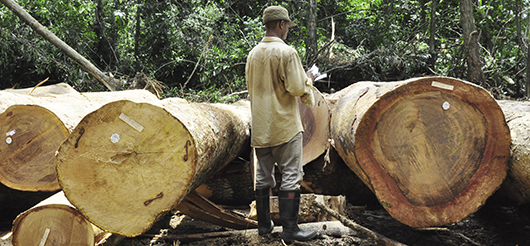What is law enforcement?
Law enforcement is the action taken by legally qualified authorities to determine non-compliance with rules and norms and to prosecute violators of those rules and norms. It may involve patrols or surveillance to deter or detect criminal activity, the investigation of crimes, and the apprehension and prosecution of offenders. Law enforcement, therefore, is one of the main tools for reducing illegal practices in the forest sector.
What is forest illegality?
Forest illegality occurs when forest products are harvested, transported, processed, bought or sold, or when forests are cleared or otherwise degraded, in violation of subnational, national or international laws. Corruption and poor governance provide an environment that perpetuates illegal behaviour. Inconsistent forest policies, unrealistic laws, and insufficient institutional capacity to enforce laws contribute to illicit activities such as illegal logging. Other drivers of forest illegality include a lack of knowledge of forest laws, and high domestic or export market demand for timber.
The scale and cost of forest illegality
The clandestine nature of illegal forest activities makes their scale and value difficult to estimate. Nevertheless, in many countries the volume of illegally harvested wood may exceed the official annual wood harvest (see cases). Illegal logging and illegal timber trade are often associated with other illegalities, such as money laundering, drug trafficking, the corruption of government officials and tax evasion.
Forest illegalities can result in very large tax losses for governments, and they can have other negative long-term economic impacts by degrading the environment and exacerbating poverty. Illegal logging jeopardizes the livelihoods of rural communities engaged in small-scale forestry by exposing them to unfair competition and depleting the resources on which they depend. Thus, efforts to promote sustainable forest management are likely to be ineffective unless forest illegalities are addressed.
Forest illegalities may lead to:
- the loss of biodiversity;
- the destruction of vital wildlife habitats;
- the destruction of livelihoods in forest communities;
- the emission of greenhouse gases;
- the loss of revenues;
- conflicts with local communities;
- human rights abuses;
- corruption and market distortions;
- political instability; and
- the exacerbation of poverty.
Enforcing forest laws
To succeed, forest law enforcement – and forest governance more generally – requires strong political commitment at all levels to address corruption and increase transparency in the forest sector. Improving forest law enforcement and governance also requires collaboration across sectors and the strong involvement of stakeholders.
Strategies to address illegal forest activities should be tailored to suit the specific local and national conditions. Efforts in the following areas may yield positive results:
- making forest laws and policies rational, equitable, transparent and streamlined;
- improving forest monitoring and information gathering;
- strengthening national institutional capacities to enforce laws; and
- formulating policies in the forest and other sectors that take into account the economic and social dynamics that underlie forest illegality.



